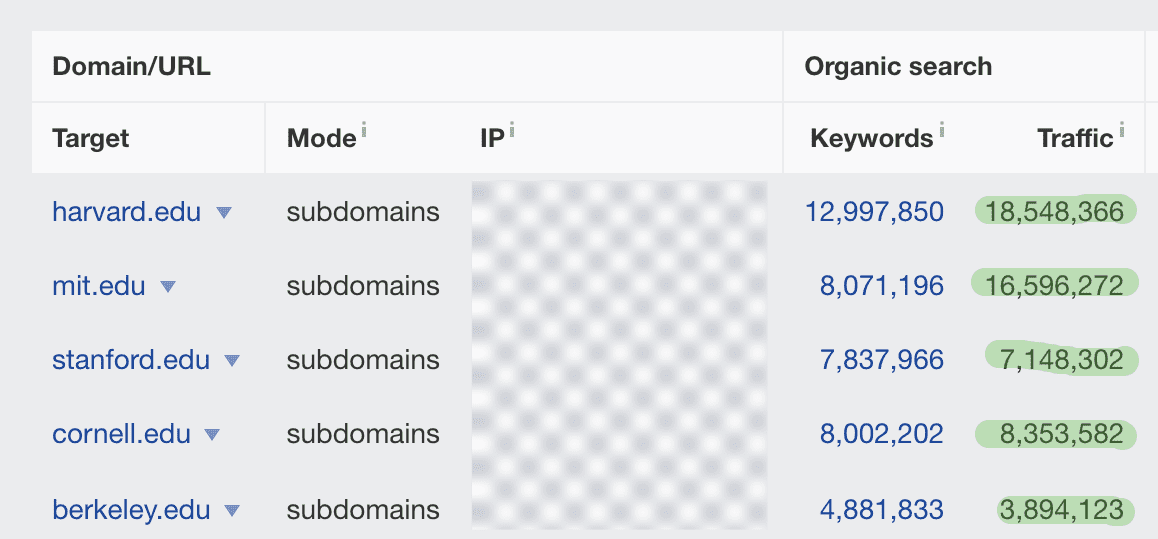3 Things every enrollment professional should do to improve their university website’s conversion rate.
There’s a lot of demand for higher education. Did you know the top 5 most visited university websites receive an average of 10.86 million monthly visitors per website? Keep in mind that’s just from organic search results, the actual total is likely much higher.

But what if you’re not an ivy league university with a billion-dollar endowment fund? Well, there’s a good chance your website still receives a steady stream of regular visitors from search engines every single month.
As you’re well aware, prospective students are doing their homework trying to decide on which university is right for them. Today, the vast majority of research is done online prior to ever stepping foot on campus. An ongoing HALDA survey shows that 51% of interested students visit a target institution's website beginning on DAY 1 of their research and 77% will gather data from a website prior to starting an application:
While this isn’t new information to you as an enrollment professional, it might surprise you to learn that most universities could capture three to five times more enrollments, on average, from existing website visits by applying conversion rate optimization best practices. The three things that every enrollment professional should do to improve their university website’s conversion rate are:
- Correctly Measure Conversion Rates
- Optimize Your Environment
- Optimize Your Forms
1. Correctly measure conversion rates.
Conversion rate optimization (CRO) is a simple concept with huge implications. For most universities, CRO is defined by the number of website visitors who take a desired action, in this case filling out an interest or application form.
Whatever percentage of website visitors take the desired action is known as your conversion rate. So, where can you get the data to find that percentage? Your website is, hopefully, equipped with something like Google Analytics (GA). Let’s take a quick deep dive into how you can get started with GA.
Getting started with Google Analytics.
Measuring conversion rates can get complicated, but it doesn’t have to be. In order to accurately measure your website’s conversion rate you only need two things:
- An Analytics Account (we recommend Google Analytics)
- Conversion Goals
If you don’t have a reliable way of measuring website visitors today, get started with a free Google Analytics account. Setup is straightforward and there are plenty of tutorials to help you get started. Once GA or other tracking software is set up, you will instantly gain access to data about how many visitors are coming and going from your pages each day. Step 1 Done!
Now that we are tracking the number of visitors, the next step is to set up a conversion goal. The easy way to do this is to create a destination URL goal. Destination goals are triggered every time a website visitor goes to a specific URL. This is typically something like a confirmation page that can only be accessed after the desired action takes place.
Destination Goals (Beginner)
To set up a destination goal in Google Analytics:
.gif?width=2880&name=Screen%20Capture%20on%202022-01-14%20at%2023-30-33%20(1).gif)
- Navigate to Admin > View > Goals
- Select New Goal from the top-left corner
- Choose a Custom goal
- Select Destination from Goal Type
- Hit Continue
- Add the URL of the destination for a completed goal
- Hit Save
The following video walks you through setting up destination and event-based goals. The tradeoff is that destination goals are easier to set up, while event-based goals are a little more accurate.
All done?! Great! Now you can accurately track the number of website visitors and the number of conversions in a given time period. From here all you need to do is a simple division problem (Goal Completions/Total Visitors) for a page and, voila, you have a consistent conversion rate that you can start to optimize.
What should my goal conversion be?
Every university is different, and sometimes your target actions on the website may vary by the time of the year. The key is to identify the actions that are most important for driving applications and enrollments. Here are our two cents about conversion goals that you could set / track:
|
Conversion Goal Target |
Outcome / Insight |
Direct Impact on Applications / Enrollment |
|
Clicks / Visits |
Helps you determine if you are getting website traffic to your target pages. |
Weak Impact. We do not recommend “Traffic” as a conversion event. Though some marketing companies will push for this, it is too easy to send “junk” clicks to your site that don’t go any farther in your enrollment funnel. |
|
Time On Page |
Helps you have a measure of how quality your content is by assessing how long it holds the attention of the visitor. |
More Impact. Measuring time on page will help you better understand the quality of both your content and your visitors. You will need to run some A/B tests to see if better traffic, better content, or both will improve time on page. |
|
RFI Form Completions |
Helps you have a measure of how quality your content, traffic, and value offer is to the visitor. |
High Impact. Once you start optimizing for completed forms you can begin to draw a straight line from traffic source all the way through to tuition dollars. You will also find that your best student prospects are on your website already. Ergo, if you can collect more leads from your website traffic, you will win more applications with less overall spend and effort. |
|
Multi-Channel Attribution |
Helps you measure the impact of every marketing activity that touched the student on their journey. |
Interesting and helpful… if you use it. You can take you tracking to the next level with multi-channel attribution. You will need to make full use of your CRM and likely some 3rd party tools to get this working right. |
For most enrollment management and marketing teams, setting a goal conversion of form submissions is a straightforward, fast, AND highly impactful metric to measure and optimize for.
2. Optimize your environment.
Choosing a goal is the easy part. What we’ve seen in working with enrollment management is that the most successful programs strive to understand the student journey. With so many distractions for the average website visitor, great conversion rates require a laser focus on the needs of your website visitors at the very moment they land on your site.
In a recent Halda research study, we found that the average university website visitor seeks to answer three primary questions as they begin their research.
- Does this program get me to where I want to go?
- Can I get in?
- How much does it cost and how am I going to pay for it?
As you think about your website visitors, and the pages they visit, focus specifically on what their intent might be behind visiting a page on your website. For example, if they visit an admissions page they are most likely trying to answer the question of whether or not they can get in. If your call-to-action on these pages is “Apply Now,” then it’s not going to resonate with your users.
By breaking down who is visiting what page on your website and seeking to understand why you’ll be better prepared to answer the questions your prospective students are asking at the moment. Answering their questions not only improves your conversion rate but helps you build trust with potential students from the moment they reach out.
Is your website designed for conversion?
Design is subjective. But what’s not subjective is the conversion rate. Having a well-designed website doesn’t mean that it’s beautiful. In fact, some studies show that ugly websites actually convert better than beautiful ones.
A shortcut to a high-converting landing page is to look for companies and organizations you know have invested a lot of time and money into conversion rate optimization and use similar layouts on your own website.
If it’s a challenge to get internal resources to create and test new landing pages, then you might be better off using Halda’s Smart Forms, like this Connecticut-based liberal arts college we recently worked with. With the application deadline looming, they had just two weeks to drive new apps. In just two weeks they saw a boost of 348 Halda Smart Form completions which doubled their total web inquiry volume.
Calls-to-action can have a meaningful impact on conversion rate if they’re well optimized. If you’re still using these CTAs, then you are missing out on potential conversions.
- Learn More
- Contacts Us
- Apply Now
By optimizing your website CTAs for the student journey and focusing on delivering value to real visitors you can rapidly improve the conversion rate across your entire site.
3. Optimize your forms.
For a lot of enrollment professionals, the form you use to collect prospective student interest is the top of the funnel. If you could only focus on a single aspect of your conversion, this is it.
Almost every institution uses the same type of RFI form that requires everything from a prospect's first name all the way down to their blood type. Ok… maybe not their blood type, but data shows that these giant forms that ask for their full date of birth as part of the first form they ever fill out with you are costing you thousands of web inquiries each year.
If the form above looks remotely similar to your forms, then there is a lot you can do to improve your outcomes by thinking hard about 1) What you are offering, 2) How you are presenting the offer, and 3) What do you require from students in order to receive the promised value.
For a lot of universities, the offer for prospective students is vague and underwhelming. Why would a potential student fill out a form 25-fields long without knowing what they’ll get in return? While this approach may have worked in years past it’s not the best way forward.
Keep in mind that today’s undergraduate applicants were born in 2003. This means that they likely took a laptop to elementary school. They likely learned to use the internet and smartphones before they learned cursive. If your offer isn’t on par with today’s best-in-class marketing technology then your university is going to suffer.
Here’s an example of a Halda Smart Form. It’s mobile-friendly, offers specific value, and asks users only for the required information to send a follow-up message.
The takeaway here is to really understand your user’s journey on the website and test valuable offers at each stage. No matter what type of form you use, you can increase conversion rates by providing a valuable offer and focusing on optimizing what’s above the fold.
What’s the takeaway?
When Halda first started working with the University of Clemson’s Graduate program, it noticed a chance to unlock untapped potential by offering more immediate value to prospective students. The resulting Smart Form helped nearly double Clemson’s inquiry volume without any change in the advertising budget.
If you’re wondering how to improve conversion rates on your website, it’s not magic. First, you must identify exactly what it is that you want to improve. Improving conversion rates starts with accurate measurement and good data. Next, you have to focus on the student journey. Next, focusing on the student experience on your website and designing a path towards conversion starts with providing real value. Finally, audit your forms—are they responsive, specific, and concise, or a little long in the tooth?
Done is always better than perfect, and that couldn’t be more true than in conversion rate optimization. So get started today, with a free 30-day trial using HALDA’s Smart Form software and see how much difference a small increase in conversion can make

